
Pssst is an action video game developed and published by Ultimate Play the Game that was released for the ZX Spectrum in June 1983. In the game, Robbie the Robot has to protect his plant as it is attacked by various insects, each of which needs a different repellent to neutralise it. Pssst was the second game to be released by Ultimate, after Jetpac.

Sabre Wulf is an action-adventure game released by British video game developer Ultimate Play the Game for the ZX Spectrum home computer in 1984. The player navigates the pith-helmeted Sabreman through a 2D jungle maze while collecting amulet pieces to bypass the guardian at its exit. The player does not receive explicit guidance on how to play and is left to decipher the game's objectives through trial and error. Sabreman moves between the maze's 256 connected screens by touching the border where one screen ends and another begins. Each screen is filled with colourful flora, enemies that spawn at random, and occasional collectibles.
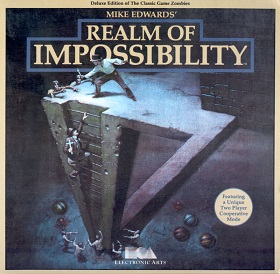
Realm of Impossibility is an action game created by Mike Edwards for Atari 8-bit computers and published by Electronic Arts in 1984. It was originally released in 1983 as Zombies by BRAM, a company formed by Edwards and a friend. BRAM previously developed and published Attack at EP-CYG-4.

Underwurlde is a 1984 action-adventure platform video game in the Sabreman series by Ultimate Play the Game for the ZX Spectrum and Commodore 64. The player controls the adventurer Sabreman as he jumps between platforms in a castle and its caverns to find an escape past the exit guardians. Underwurlde features about 600 flip screen areas. Unlike other games of its time, Sabreman is not injured when touched by enemies and is instead knocked backwards. Underwurlde is the second game in the series, between Sabre Wulf and Knight Lore, and released shortly before the latter for the ZX Spectrum in late 1984. Another developer, Firebird, ported the game to the Commodore 64 the next year.
CDS Software was an independent publisher and developer of computer game software based in Doncaster, South Yorkshire, UK.
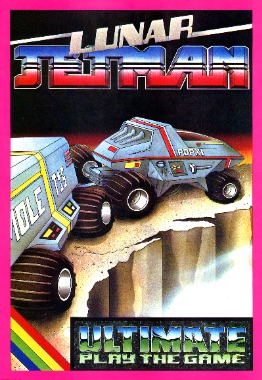
Lunar Jetman is a horizontally scrolling shooter developed and published by Ultimate Play the Game. It was released for the ZX Spectrum in 1983 and later on the BBC Micro. In this sequel to Jetpac, the second instalment of the Jetman series, Jetman has to destroy alien bases whilst simultaneously defending himself, along with Earth, from a hostile alien race.

Bomb Jack is a platform game published by Tehkan for arcades and later ported to home systems. The game was a commercial success for arcades and home computers. It was followed by several sequels: the console and computer game Mighty Bomb Jack, the arcade game Bomb Jack Twin, and Bomb Jack II which was licensed for home computers only.
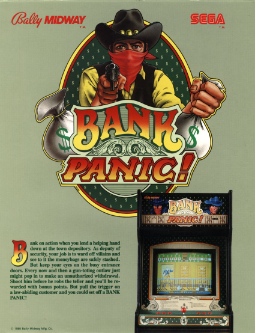
Bank Panic is an arcade shooter game developed by Sanritsu Denki and released by Sega in 1984. Bally-Midway manufactured the game in the US. The player assumes the part of an Old West sheriff who must protect a bank and its customers from masked robbers.

Sherlock is a 1984 text adventure developed under the lead of Philip Mitchell by Beam Software. It was published by Melbourne House. Five programmers worked for 18 months on the title and a Sherlock Holmes expert was employed full-time for a year to advise the team on accuracy.
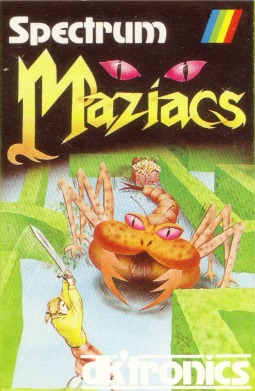
Maziacs is an action adventure maze game published by DK'Tronics in 1983 for the ZX Spectrum, Commodore 64, and MSX.
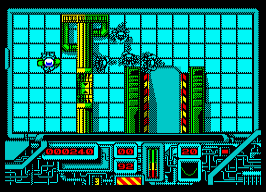
Denizen is an action computer game published by Players Software in 1988 for the ZX Spectrum.
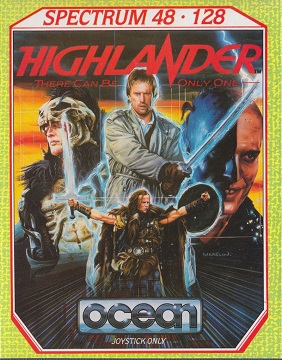
Highlander is a video game tie-in to the Highlander franchise released in 1986, the same year as the film, published by Ocean Software for the ZX Spectrum, Commodore 64 and Amstrad CPC home computers. Highlander was panned by reviewers.
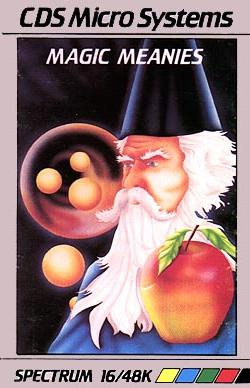
Magic Meanies is a ZX Spectrum video game developed and released by CDS Micro Systems in 1983. Magic Meanies is a clone of Universal's Mr. Do! arcade game.

Blade Runner is a 1985 shoot 'em up game loosely inspired by the 1982 film Blade Runner. The game was published in 1985 by CRL Group PLC for Commodore 64, ZX Spectrum, and Amstrad CPC. Reviews of the game were mostly negative.

Check Man is an arcade video game released by Zilec-Zenitone in 1982. While being a fast-paced action game, there are puzzle elements to the gameplay. The game uses the Namco Galaxian arcade board. It was one of the first British video games to be successful in overseas markets, particularly Japan.

Shadowfire is a video game for the ZX Spectrum and Commodore 64 and later the Amstrad CPC. It was developed by British developer Denton Designs and published by Beyond Software in 1985. The player must direct the Enigma Force to rescue Ambassador Kryxix from the traitor Zoff's flagship before the timer runs out and secret plans for a new type of starship are discovered. Shadowfire was one of the first games to use a menu-and-icon-driven interface. It was well received by reviewers of the time, and followed by a sequel, Enigma Force.

Isometric video game graphics are graphics employed in video games and pixel art that use a parallel projection, but which angle the viewpoint to reveal facets of the environment that would otherwise not be visible from a top-down perspective or side view, thereby producing a three-dimensional (3D) effect. Despite the name, isometric computer graphics are not necessarily truly isometric—i.e., the x, y, and z axes are not necessarily oriented 120° to each other. Instead, a variety of angles are used, with dimetric projection and a 2:1 pixel ratio being the most common. The terms "3/4 perspective", "3/4 view", "2.5D", and "pseudo 3D" are also sometimes used, although these terms can bear slightly different meanings in other contexts.

The Train Game is a simulation video game originally published by Microsphere for the ZX Spectrum in 1983.
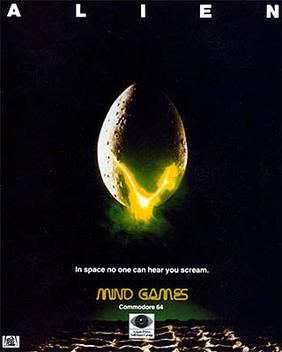
Alien is a 1984 hybrid strategy/adventure video game developed by Concept Software and published by Argus Press Software for the Commodore 64 and ZX Spectrum, and later ported for the Amstrad CPC in 1985. It is based on the science fiction horror film Alien.
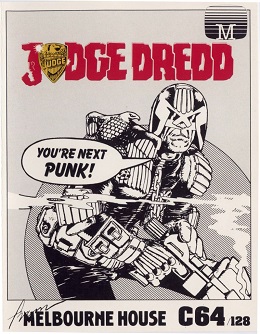
Judge Dredd is a platform shoot 'em up video game based on the character of the same name. It was developed by Beam Software and published by Melbourne House. It was released in Europe in 1986, for Commodore 64 and ZX Spectrum.



















